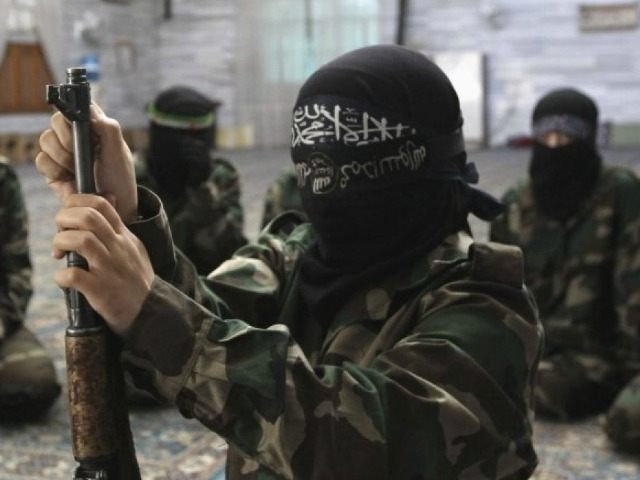The Islamic State’s “caliphate” in Iraq and Syria shrunk by 14 percent in 2015, according to an analysis by IHS, a defense research firm.
However, the group, known as ISIS/ISIL, has expanded its presence outside its home turf in Iraq in Syria where it is facing a U.S.-led coalition.
ISIS has gained territory in Afghanistan, Libya, Egypt, and Yemen.
“Using open source intelligence including social media and sources inside the countries, the team at IHS estimates that the Islamic State’s ‘caliphate’ shrunk by 12,800 km2 to 78,000 km2 between 1 January and 14 December 2015, a net loss of 14 percent,” notes the defense research firm.
In 2015, ISIS lost large swathes of Syria’s northern border with Turkey, including the Tal Abyad border crossing, according to IHS.
The border crossing served as the main access point to Turkish border from Raqqa, the jihadist group’s de-facto capital.
“We had already seen a negative financial impact on the Islamic State due to the loss of control of the Tal Abyad border crossing prior to the recent intensification of airstrikes against the group’s oil production capacity,” said Columb Strack, a senior IHS analyst.
“Other substantial losses in Iraq include the city of Tikrit, the fiercely contested Baiji refinery complex, and a stretch of the main highway between Raqqa and Mosul, which complicates the transfer of goods and fighters between the two largest IS-controlled cities,” added Strack.
Meanwhile, Gen. John Campbell, the top commander of U.S. and NATO forces in Afghanistan, recently warned that the number of ISIS supporters there is growing.
A United Nations report released in September revealed that ISIS is expanding its presence in Afghanistan as it actively recruits followers in nearly three-quarters (25) of the country’s 34 provinces.
The jihadists group announced the establishment of its Khorasan province in January. Khorasan is ancient name for a region that covers parts of Afghanistan, Pakistan, Iran, India and other surrounding countries.
ISIS has also established a foothold in Libya, mainly in the coastal city of Sirte, which is the closest the terrorist group has gotten to mainland Europe, according to the Independent. The Pentagon confirmed that ISIS leader Abu Nabil, an Iraqi national, was killed by a U.S. airstrike in Derna, Libya on Nov. 13.
Earlier this month, Col. Steve Warren, the Baghdad-based spokesman for the U.S.-led coalition against ISIS, acknowledged that ISIS will seek to expand into areas “such as North Africa, Libya and the Sinai” as America makes progress against the jihadist group in Iraq and Syria.
“We know that ISIL will follow the path of least resistance, and as we continue to degrade their capability here in their stronghold of Iraq and Syria – you know, we have to expect and plan for them to try – to attempt to gain footholds elsewhere,” Col. Warren told reporters.
The ISIS branch in Egypt’s Sinai peninsula took responsibility for taking down a Russian passenger plane in October, killing all 224 passengers.
Furthermore, a new branch of the Islamic State is reportedly on the rise in Yemen.
“Nine months of war between a Saudi-led military coalition and a Yemeni rebel group have left thousands of civilians dead, a nation gravely polarized and the land strewn with debris, mines and unexploded bombs,” reports The New York Times (NYT).
“The conflict has produced another bitter legacy: a new branch of the Islamic State that has quietly grown in strength and appears determined to distinguish itself as Yemen’s most disruptive and brutal force, carrying out attacks considered too extreme even by the country’s branch of Al Qaeda,” it adds.
Although ISIS has lost territory in Iraq and Syria, it has also made gains in those two countries, IHS points out.
“The Islamic State’s most significant gains in 2015 came from their advance into western Syria via Palmyra, and the capture of Ramadi’s city centre [in Iraq],” said Strack, the IHS analyst.
“Both were achieved in a near simultaneous offensive in May 2015, but came at the expense of losing northern Syria to the Kurds,” notes IHS.
In order to launch the offensives in Palmyra and Ramadi, ISIS sent reinforcements from its northern frontline with the Kurds.
“This indicates that the Islamic State was overstretched, and also that holding Kurdish territory is considered to be of lesser importance than expelling the Syrian and Iraqi governments from traditionally Sunni lands,” explained Strack.
“Geospatial analysis of our data shows that Islamic State activity outside areas it controls is heavily concentrated around Baghdad and Damascus, but much less so in Kurdish territory. The Kurds appear to be primarily an obstruction to the Islamic State, rather than an objective in themselves,” he added.

COMMENTS
Please let us know if you're having issues with commenting.